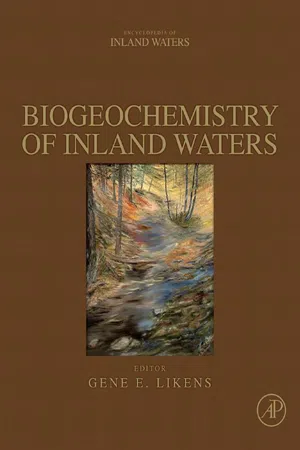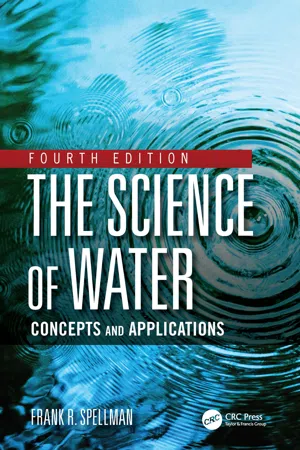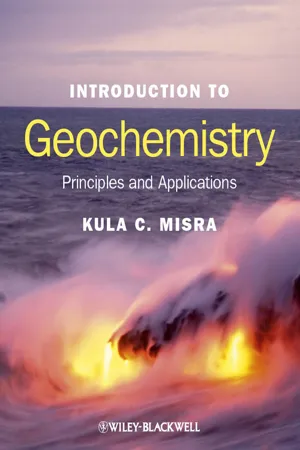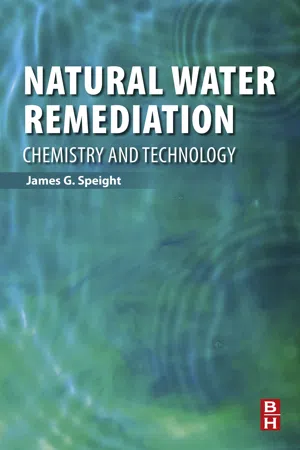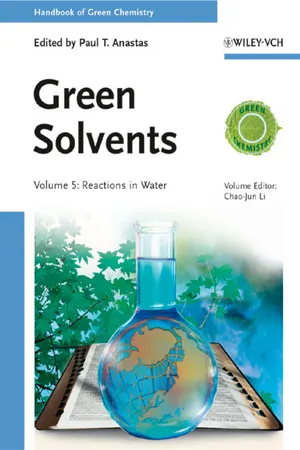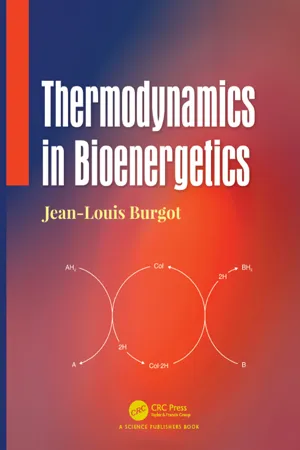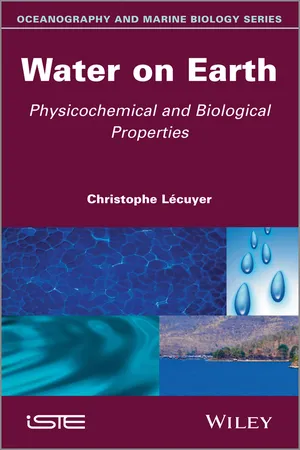Chemistry
Water in Chemical Reactions
Water plays a crucial role in chemical reactions as a solvent, reactant, or product. It can act as a medium for reactions to occur, participate in hydrolysis reactions, and contribute to acid-base chemistry. Additionally, water's ability to dissolve a wide range of substances makes it essential for many chemical processes.
Written by Perlego with AI-assistance
Related key terms
Related key terms
1 of 4
Related key terms
1 of 3
10 Key excerpts on "Water in Chemical Reactions"
- eBook - ePub
- Gene E. Likens(Author)
- 2010(Publication Date)
- Academic Press(Publisher)
Properties of WaterPassage contains an image
Chemical Properties of Water
J.H. Aldstadt, III; H.A. Bootsma University of Wisconsin-Milwaukee, Milwaukee, WI, USAJ.L. Ammerman SEAL Analytical, Inc., Mequon Technology Center, Mequon, WI, USAWater is H2 O, hydrogen two parts, oxygen one, but there is also a third thing, that makes it water and nobody knows what it is.—D.H. Lawrence (1929)Introduction
Water is the most abundant molecule on Earth. In spite of being so common, water is quite unusual – from its high melting and boiling points to its tremendous solvating power, high surface tension, and the largest dielectric constant of any liquid. In this article, we present an overview of the chemical properties of water. The phrase ‘chemical property’ is context dependent, which we define in general as a description of the way that a substance changes its identity in the formation of other substances. A universally accepted set of chemical properties does not exist in the same way that there is, more or less, a standard set of physical properties for a given substance. Whereas a given substance has intrinsic physical properties (such as melting point), by our definition chemical properties are clearly tied to change. In addition to reactivity, a substance’s ‘chemical properties’ also typically include its electronegativity, ionization potential, preferred oxidation state(s), coordination behavior, and the types of bonding (e.g., ionic, covalent) in which it participates. Because these properties are extensively studied in general chemistry courses, we will not further discuss them here. Rather, we move beyond the basic general chemistry concepts and focus upon water in a limnologic context – particularly, its bulk fluid structure and aspects of its chemical reactivity in the hydrosphere.In the following pages, we begin by briefly reviewing the molecular structure of water and then discuss models for its structure in ‘bulk’ solution. We then turn our attention to the hydration of ions and an overview of important reactions that involve water, including acid–base, complexation, precipitation, and electron transfer. We conclude with a look at trends in the chemical composition of freshwater that are fundamental to the field of limnology. - eBook - ePub
Foods That Harm, Foods That Promote Health
A Biochemical and Nutritional Perspective in Health and Disease Prevention
- Stefan A. Hulea, Ahmadi(Authors)
- 2021(Publication Date)
- Universal Publishers(Publisher)
In this way, protons can travel over a considerable long distance, which has important biological consequences. Water can also be the end product of a metabolic pathway. Thus, the degradation of sugars and fatty acids yield the metabolic water.Water, despite what some people think, is a reactive molecule available in many systems at high concentration. However, at room temperature water reactivity is greatly diminished due to the presence of H bonds. By dissociating in H+ and OH- water makes possible many biochemical reactions. At high temperatures there is a massive reduction in the number of H bonds so water becomes more reactive than at ambient temperature.It is not our intention to go further into details of the physical properties of water clusters in bulk or ice form since they are much better explained in two recent texts (2 , 3 ).3.2. Water in biological systems
There is a fair proportion of ordered water molecules in living systems. Thus, inside cells water molecules “coat” substrates and enzymes as ordered shells. As substrates bind to enzymes some of this ordered water shell is removed. What is important to bear in mind is that there are regions of ordered water around micro- and macromolecules in all cell compartments. These ordered water shells exist because of H bonds between water and various organic molecules. That explains why water is such a good solvent for so many substances ranging from ionic (charged) to polar (neutral).With the former water interacts electrostatically while with the latter it forms H bonds. That also explains why water, among all other substances of similar molecular weight and atomic configuration is the only medium that supports life.It is now apparent that interfacial water molecules modulate protein function and that nanoconfined water is so different from bulk water that in studying it the statistical physics models developed for bulk water cannot be applied to the former. It is also apparent that physical properties of water can play a key role in the orchestration of cell machinery. The fuzzy structures observed in the hyaloplasm long ago by the eminent cytologist Keith Porter (4 ) seem to structure the nearby water molecules into a strongly constrained water, called interfacial water (5 - eBook - ePub
River Ecosystem Ecology
A Global Perspective
- Gene E. Likens(Author)
- 2010(Publication Date)
- Academic Press(Publisher)
University of Wisconsin-Milwaukee, Milwaukee, WI, USAJ.L. Ammerman SEAL Analytical, Inc., Mequon Technology Center, Mequon, WI, USAWater is H2 O, hydrogen two parts, oxygen one, but there is also a third thing, that makes it water and nobody knows what it is.—D.H. Lawrence (1929)Introduction
Water is the most abundant molecule on Earth. In spite of being so common, water is quite unusual – from its high melting and boiling points to its tremendous solvating power, high surface tension, and the largest dielectric constant of any liquid. In this article, we present an overview of the chemical properties of water. The phrase ‘chemical property’ is context dependent, which we define in general as a description of the way that a substance changes its identity in the formation of other substances. A universally accepted set of chemical properties does not exist in the same way that there is, more or less, a standard set of physical properties for a given substance. Whereas a given substance has intrinsic physical properties (such as melting point), by our definition chemical properties are clearly tied to change. In addition to reactivity, a substance’s ‘chemical properties’ also typically include its electronegativity, ionization potential, preferred oxidation state(s), coordination behavior, and the types of bonding (e.g., ionic, covalent) in which it participates. Because these properties are extensively studied in general chemistry courses, we will not further discuss them here. Rather, we move beyond the basic general chemistry concepts and focus upon water in a limnologic context – particularly, its bulk fluid structure and aspects of its chemical reactivity in the hydrosphere.In the following pages, we begin by briefly reviewing the molecular structure of water and then discuss models for its structure in ‘bulk’ solution. We then turn our attention to the hydration of ions and an overview of important reactions that involve water, including acid-base, complexation, precipitation, and electron transfer. We conclude with a look at trends in the chemical composition of freshwater that are fundamental to the field of limnology. - eBook - ePub
The Science of Water
Concepts and Applications
- Frank R. Spellman(Author)
- 2020(Publication Date)
- CRC Press(Publisher)
3 . The formula shows that this compound is made up of three elements: sodium, carbon, and oxygen. In addition, there are two atoms of sodium, one atom of carbon, and three atoms of oxygen in each molecule.As mentioned, when depicting chemical reactions, chemical equations are used. The following equation shows a chemical reaction that most water/wastewater operators are familiar with: Chlorine gas added to water. It shows the formulas of the molecules that react together and the formulas of the product molecules.+Cl2H 2O → HOCl + HClAs stated previously, a chemical equation tells what elements and compounds are present before and after a chemical reaction. Sulfuric acid poured over zinc will cause the release of hydrogen and the formation of zinc sulfate. This is shown by the following equation:Zn +H 2→SO4+ZnSO4H 2One atom (also one molecule) of zinc unites with one molecule of sulfuric acid and gives one molecule of zinc sulfate and one molecule (two atoms) of hydrogen. Notice that there is the same number of atoms of each element on each side of the arrow. However, the atoms are combined differently.Let us look at another example. When hydrogen gas is burned in air, the oxygen from the air unites with the hydrogen and forms water. The water is the product of burning hydrogen. This can be expressed as an equation:
This equation indicates that two molecules of hydrogen unite with one molecule of oxygen to form two molecules of water.+2H2→O2O2H2Water Solutions
A solution is a condition in which one or more substances are uniformly and evenly mixed or dissolved. A solution has two components: a solvent and a solute. The solvent is the component that does the dissolving. The solute is the component that is dissolved. In water solutions, water is the solvent. Water can dissolve many other substances—given enough time, there are not too many solids, liquids, and gases that water cannot dissolve. When water dissolves substances, it creates solutions with many impurities.Generally, a solution is usually transparent and not cloudy. However, a solution may be colored when the solute remains uniformly distributed throughout the solution and does not settle with time. - eBook - ePub
- Ian Bradbury, John Boyle, Andy Morse(Authors)
- 2014(Publication Date)
- Routledge(Publisher)
42The chemistry of water42.1 IntroductionThe physical properties of water are described, and a physical model to explain these properties is provided in 41 . Here, we consider the behaviour of water from a chemical point of view. As with physical properties, water is chemically unusual in a number of respects. Water is one of the few inorganic substances which is liquid at room temperature. However, there are three other aspects of the chemical properties which are striking:- Water is extremely good at attacking metallic and ionic solids and bringing them into solution.
- Because of its ability to carry ionic substances in solution it is, in its impure state, very good at conducting electrical currents.
- For reasons related to both of these points, water is very good at enhancing chemical reactions.
Why can such a wide range of substances be dissolved in water? A solution results from the uniform dispersal of one substance – the solute – within another – the solvent . By dispersal, we mean that a substance is broken into molecules and held indefinitely in solution. The solute can be solid, gas or liquid, whereas the solvent is usually a liquid. In order for dissolution to occur, there must be stronger forces of attraction between solute and solvent than between solvent alone or solute alone. Clearly, water can attach very strongly to ions, and any chemical model for water must be able to explain this.Because of its ability to dissolve ions, water is very effective at conducting electrical charges. Thus, natural water is a good electrical conductor. (In its pure state, water is a poor conductor, but it is rarely pure.) The conductivity of water has a great impact on its ability to promote oxidation and reduction reactions. The conduction of charge by dissolved salts is also central to the physiology of all living organisms. - eBook - ePub
Introduction to Geochemistry
Principles and Applications
- Kula C. Misra(Author)
- 2012(Publication Date)
- Wiley-Blackwell(Publisher)
7 Reactions Involving Aqueous Solutions Aquatic chemistry is concerned with the chemical processes affecting the distribution and circulation of chemical compounds in natural waters; its aims include the formulation of an adequate theoretical basis for the chemical behavior of ocean waters, estuaries, rivers, lakes, groundwaters, and soil water systems, as well as the description of the processes involved in water treatment. Obviously, aquatic chemistry draws primarily on the fundamentals of chemistry, but it is also influenced by other sciences, especially geology and biology. Stumm and Morgan (1981) Water, the most abundant liquid on Earth, plays an important role in almost all geochemical and biochemical processes. These include chemical weathering, formation of chemical and biochemical sediments, diagenesis, transport and accumulation of contaminants, metamorphism, and even magmatic crystallization. Understanding the behavior of aqueous solutions, therefore, is an essential aspect of geochemistry. Water is a remarkable naturally occurring compound with many unusual properties. Water has a much higher boiling point compared to other hydrides of higher molecular weight (e.g., H 2 S) so that it is a liquid at room temperature. It has the highest heat capacity of all common liquids (except ammonia) and solids (a property of considerable climatic significance considering the extent of oceans on the Earth’s surface), the highest latent heat of vaporization of all common substances, and the highest surface tension of all common liquids. Its maximum density occurs at 4°C, ice being less dense than liquid water. This is why aquatic life can be supported by water below a few meters of ice in a frozen body of water, and freezing of water in the cracks of rocks is an important mechanism of mechanical weathering in cold climates - eBook - ePub
Natural Water Remediation
Chemistry and Technology
- James G. Speight(Author)
- 2019(Publication Date)
- Butterworth-Heinemann(Publisher)
The components of water chemical composition are the main characteristics of water quality that define its fitness for particular kinds of water use. Water quality assessment is performed according to certain parameters of water properties and composition, including concentrations of polluting harmful and toxic substances, which are categorized according to a harmfulness index. The standards of pollutant concentrations adopted in various countries are variously known as quality criteria and include but are not limited to (i) concentration standards, (ii) maximum allowable concentrations, and (iii) maximum allowable levels. Other measures of chemical substances dangerous for biota include classifications based on their type of effect—toxicity, carcinogenicity, and mutagenicity. Different requirements specified for water quality are regulated by state normative documents, regulations on surface water protection from pollution, and standing standards. For this reason and also because of natural differences in chemical composition of water bodies in different regions, establishment of common, strict norms for water quality can be problematic.Water is also one of the most important resources in the chemical process industries (CPI)—presenting both opportunities as well as environmental compliance obligations. It is involved in a broad range of operations, including separations, product recovery, wastewater treatment, and disinfection, to name a few. Because of its pervasiveness, water requires a new technological definition through which environmental scientists and environmental engineers view their study and work.Rocks are composed primarily of minerals, naturally crystallized materials having a periodic structure. The long-range structure of crystals, expressed internally as the periodic lattice, determines their fundamental physical and chemical properties. Water, in addition to supplying the basis for life on Earth, is also its critical solvent. It is the dominant medium through which rocks and minerals communicate during chemical precipitation and dissolution reactions. However, at room temperature the mobility of ions via diffusion to and from sites in the solid bulk crystal is extremely limited. Dissolution and precipitation reactions thus usually occur at the mineral-water interface - eBook - ePub
Green Solvents, Volume 5
Reactions in Water
- Paul T. Anastas(Author)
- 2014(Publication Date)
- Wiley-VCH(Publisher)
1 The Principles of and Reasons for Using Water as a Solvent for Green Chemistry Ronald Breslow1.1 Introduction
Chemical reactions used to manufacture important compounds such as medicinals are essentially always carried out in solution, and this is also true of the research work that is used to invent the new compounds and to develop appropriate ways to manufacture them. In the past, continuing into the present, the solvents used are normally volatile organic compounds (VOCs), and these pose an environmental problem. Their vapors can contribute to the greenhouse effect that causes global warming, and in some cases the solvent vapors can catalyze the destruction of the ozone layer that protects the Earth and its living inhabitants from short-wavelength ultraviolet solar radiation. The vapors may also be toxic to humans, plants, or animals, or they may cause diseases.The liquids themselves can be a problem. If they are released into the earth, rivers or the ocean, they can cause direct environmental damage, while also slowly releasing their vapors. In principle, the solvents can be completely captured and purified for reuse during manufacturing, but it is difficult to prevent some loss to the environment. Hence there is interest in using environmentally benign liquids as the solvents in chemical reactions.One possibility is supercritical carbon dioxide, which is a liquid under pressure and which has attractive solvent properties. However, unless it is completely contained and reused, it will release gaseous carbon dioxide, a greenhouse gas. Thus interest has increasingly turned to water as the solvent for chemical reactions.Water is the solvent in which biochemical reactions are performed in Nature, and it is environmentally benign. However, it is a good solvent only for organic chemicals that have polar groups, such as alcohols and carboxylic acids. This may not be an insuperable problem. Over 20 years ago we reported that the special selectivities seen in water solution (see below) were also seen in some water suspensions, where one soluble component reacted with one that was poorly soluble [1, 2]. We pointed out that such suspensions in water could well be generally more practical ways to use water in manufacturing [2]. Recently, Sharpless and co-workers described a remarkable acceleration of a reaction in such a suspension, which they called reactions ON water [3, 4]. The large reported rate effect was seen in only one particular case, but even without a large acceleration the selectivities that we describe below could perhaps make suspensions in water a practical way for the environmentally benign properties of water to be generally useful even with insoluble reaction components. - eBook - ePub
- Jean-Louis Burgot(Author)
- 2019(Publication Date)
- CRC Press(Publisher)
Part IISome Aspects of Chemical Reactions in Aqueous Solutions
Passage contains an image
Chapter 26Acid-Base Reactions in Aqueous Solutions
Biochemical reactions occurring in bioenergetics obey the same principles as do the chemical ones. In this chapter and in the two following ones, we recall some essential points concerning the principal chemical equilibria occurring in water and encountered during the evolution of the biochemical reactions. We have chosen to essentially develop the acid-base and the redox reactions in water. They are probably the most important equilibria for our purpose. We also mention some other kinds of processes which are also of interest for us, but at a less extent than the preceding ones. As for the choice of water as solvent, it is justified by the fact that a living cell is essentially an aqueous medium.The goal of this chapter and of the following ones is to facilitate the prediction of the directions of the reactions of bioenergetics, that is to say to facilitate their forecasting. Finally, these studies must justify the directions the reactions actually take.The contents of these chapters are strongly reminiscent of the physico-chemical theories devoted to the chemistry of aqueous solutions. In this chapter, we are concerned by acid-base reactions.There are several definitions of acids and bases. We confine ourselves to giving that of Arrhenius’ very briefly and, then, to more thoroughly studying the Brönsted-Lowry’s theory.1) Definitions of acids and bases and consequences
– According to Arrhenius theory, an acid HA is a species that ionizes in water to give one hydrated proton H+ (w) and one anion according to the more or less equilibrated reaction:HA ⇌A −( w )+H +( w )(143) A base BOH is a substance that ionizes in water to give one hydroxide anion OH− (w) and one cation according to:BOH ⇌B +( w )+OH −( w )(144) There exist polyacids and polybases. Polyacids give several hydrated protons per molecule, while polybases give several hydroxide anions. The strengths of acids and bases are related to the extent of the ionization processes of reactions (140) and (141) - eBook - ePub
Water on Earth
Physicochemical and Biological Properties
- Christophe Lécuyer(Author)
- 2013(Publication Date)
- Wiley-ISTE(Publisher)
Chapter 1
Water: A Molecule Endowed with Extraordinary Physicochemical Properties
1.1. Molecular geometry and electrical properties
A water molecule consists of an oxygen atom bonded to two hydrogen atoms. In water, each hydrogen atom is bound to the oxygen by a pair of electrons. However, only two of the six outer-shell electrons of oxygen are used to form covalent bonds, the remaining four being organized into two non-bonding pairs (Figure 1.1 ). The four electron pairs surrounding the oxygen tend to arrange themselves as far from each other as possible in order to minimize repulsions between these clouds of negative charge. However, the two non-bonding pairs exert a strong repulsion against the two covalent bonding pairs, which results in a deformed tetrahedral geometry with a angle of 105° instead of the theoretical angle of 109°. As a result, the H2 O molecule is electrically neutral even though the electrical charges are not distributed uniformly. Indeed, a negative charge is associated with the oxygen atom while the hydrogen atom carries a positive charge (Figure 1.2 ). This electronic configuration defines the polar structure of water molecules, which consequently have a mutual attraction and tend to stick together.This process is called “hydrogen bonding” and explains why water is a liquid instead of a gas under standard conditions (close to the Earth’s surface pressure and temperature conditions). In comparison to a covalent bond, the hydrogen bond is so weak that the timescale of its life expectancy is in the order of the picosecond (10−12 s), therefore explaining the low molecular viscosity of water (
Index pages curate the most relevant extracts from our library of academic textbooks. They’ve been created using an in-house natural language model (NLM), each adding context and meaning to key research topics.
Explore more topic indexes
Explore more topic indexes
1 of 6
Explore more topic indexes
1 of 4
